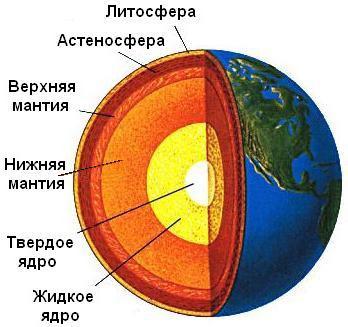The upper solid shell of the Earth is called the crust and enters the lithosphere, which is literally translated from the Greek language as “rocky” or “hard ball”. It includes a part of the upper mantle. All this is located directly above the asthenosphere ("powerless ball") - above a more viscous or plastic layer, as it were, underlying the lithosphere.
Earth's internal structure

Our planet has the shape of an ellipsoid, or, more precisely, a geoid, which is a three-dimensional geometric body of a closed shape. This most important geodetic concept is literally translated as "similar to the Earth." This is how our planet looks externally. It is internally structured as follows - the Earth consists of layers separated by borders that have their own specific names (the clearest of them - the border of Mohorovichich, or Moho, divides the crust and mantle). The core, which is the center of our planet, the shell (or mantle) and the crust - the upper solid shell of the Earth - these are the main layers, two of which - the core and the mantle, in turn, are divided into 2 sublayers - inner and outer, or lower and upper. So, a core with a sphere radius of 3.5 thousand kilometers consists of a solid inner core (radius 1.3) and a liquid outer one. And the mantle, or silicate shell, is divided into lower and upper parts, which together account for 67% of the total mass of our planet.
The thinnest layer of the planet
The upper solid surface of the Earth is a rather thin upper shell (on land - 40-80 km, under water - 10-15). It accounts for only 1% of the total mass of the Earth. The earth's crust consists of two types - the land is continental, the seabed is oceanic.
There are transition zones located mainly on the shores of the oceans - island-arc. The geographically thickest part of the earth's crust is in the mountains, in particular in the Himalayas (75 km), the center of the ocean is its thinnest part (5-7 km). The thickness of the lithosphere itself on land and on the ocean floor is 25-200 and 5-100 kilometers, respectively. It should be noted that the lithosphere does not include the entire upper layer of the mantle, but only a small part of it up to several tens of kilometers, while the layer itself reaches from 500 to 900 km.
Physical and chemical composition of the Earth

The Earth’s hard shell consists of three types of rocks - sedimentary (clastic,
chemical, biogenic), igneous, or igneous (they account for 95% of the entire lithosphere: granites prevail on land and basalts on the bottom), and metamorphic (formed in the earth's thickness). Under the oceanic water column, the crust consists of two layers. 99.5% of the chemical composition of the Earth’s upper hard shell is accounted for by hydrogen and oxygen, aluminum and silicon, iron and magnesium, calcium and sodium — only eight elements of the periodic table. All information about the internal structure of the Earth are theoretical scientific solutions. For direct study, only the upper hard shell of the Earth is available, because modern man cannot physically get to the next layer. Therefore, all questions regarding the structure of our planet are controversial. However, not everything has been proved and investigated on the surface. The origin of the earth's crust remains controversial. Therefore, all directions of studying the lithosphere are so relevant. Available minerals are concentrated in it, and in the very top of it there are soils that are so significant in human life.
Features of the lithosphere
So, the boundaries of the lithosphere can be determined by the interface, which bears the name of the Serbian geophysicist Mohorovicic, and which is determined by the differences in the velocities of seismic waves. And within these boundaries, severe, threatening environmental disasters occur processes - shifts, including tectonic, landslides and mudflows, soil erosion.
Soils themselves arose simultaneously with life on Earth and are the product of environmental influences - water, air, living organisms and plants. Depending on various conditions (geological, geographical and climatic), this most important natural resource has a thickness of 15 cm to 3 m. The value of some types of soils is very high. For example, during the occupation by rolls, the Germans exported Ukrainian black soil to Germany. Speaking about the earth's crust, one cannot but say about
lithospheric plates, which are large solid sections, sliding along the more fluid layers of the mantle and moving relative to each other. Their rapprochement and “collisions” threaten with tectonic shifts, which can be the cause of disasters on Earth.